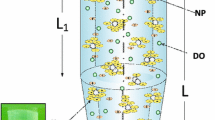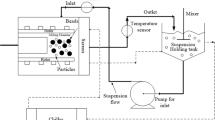Abstract
In order to better understand and predict the release of proteins from bioerodible microspheres or nanospheres, it is important to know the influences of different initial factors on the release mechanisms, though often it is difficult to assess what exactly is at the origin of a certain dissolution profile. We propose here a new class of fine-grained multi-agent models built to incorporate increasing complexity, permitting the exploration of the role of different parameters, especially that of the internal morphology of the spheres, in the exhibited release profile. This approach, based on Monte Carlo (MC) and cellular automata (CA) techniques, has permitted the testing of various assumptions and hypotheses about several experimental systems of nanospheres encapsulating proteins. Results have confirmed that this modelling approach has increased the resolution over the complexity involved, opening promising perspectives for future developments, especially complementing in vitro experimentation.












Similar content being viewed by others
Notes
Sometimes the drug has to move through some narrow passageways which are produced by the vibrations of the polymer chain and control the actual size for the passage of macromolecules (Zhang et al. 2003).
References
Barat A (2006) Probabilistic methods for drug dissolution, PhD thesis, Dublin City University
Batycky RP, Hanes J, Langer R, Edwards DA (1997) A theoretical model of erosion and macromolecular drug release from biodegrading microspheres. J Pharm Sci 86(12):1464–1477
Charlton D, Peterson M, Spiller K, Lowman A, Torzilli P, Maher S (2006) Mechanical characterization of a Novel Scaffold for the repair of articular cartilage. Private communication
Feng S (2006) Chemotherapeutic engineering: polymeric nanoparticles for clinical administration of anticancer drugs. Access date: 14/11/2006
Feng S, Chien S (2003) Chemotherapeutic engineering: application and further development of chemical engineering principles for chemotherapy of cancer and other diseases. Chem Eng Sci 58:4087–4114
Göpferich A (1995) Modeling of polymer erosion in three dimensions: rotationally symmetric devices. Am Inst Chem Eng (AIChE) J 41(10):2292–2299
Göpferich A (1996) Mechanisms of polymer degradation and erosion. Biomaterials 17:103–114
Göpferich A (1997a) Bioerodible implants with programmable drug release. J Control Release 44:271–281
Göpferich A (1997b) Erosion of composite polymer matrices. Biomaterials 18:397–403
Göpferich A, Langer R (1995) Modeling monomer release from bioerodible polymers. J Control Release 33:55–69
Kang F, Singh J (2001) Effect of additives on the release of a model protein from PLGA microspheres. AAPS PharmSciTech 2(4):30
Kilic AC, Capan Y, Vural I, Gursoy RN, Dalkara T, Cuine A, Hincal AA (2005) Preparation and characterization of PLGA nanospheres for the targeted delivery of NR2B-specific antisense oligonucleotides to the NMDA receptors in the brain. Journal of Microencapsul 22(6):633–641
Kisler JM, Stevens GW, O’Connor AJ (2001) Adsorption of proteins on mesoporous molecular sieves. Mater Phys Mech 4:89–93
Kosmidis K, Rinaki E, Argyrakis P, Macheras P (2003) Analysis of case ii drug transport with radial and axial release from cylinders. Int J Pharm 254:181–188
Lam X, Duenas E, Daugherty A, Levin N, Cleland J (2000) Sustained release of recombinant human insulin-like growth factor-I for treatment of diabetes. J Control Release 67:281–292
Merkle H, Gander B, Meinel L, Walter E (2002) Novel opportunities of microparticulates for the delivery of therapeutics and vaccines, Technical report
Nicholson C, Sychova E (1998) Extracellular space structure revealed by diffusion analysis. Trends Neurosci 21(5):207–215
Sandor M, Enscore D, Weston P, Mathiowitz E (2001) Effect of protein molecular weight on release from micron-sized PLGA microspheres. J Control Release 76:297–311
Siepmann J, Faisant N, Benoit J-P (2002) A new mathematical model quantifying drug release from bioerodible microparticles using Monte Carlo simulations. Pharm Res 19(12):1885–1893
ul Ain Q, Sharma S, Khuller GK (2003) Chemotherapeutic potential of orally administered poly(lactide-co-glycolide) microparticles containing isoniazid, rifampin, and pyrazinamide against experimental tuberculosis. Antimicrob Agents Chemother 47(9):3005–3007
Ungaro F, Biondi M, Indolfi L, Rosa GD, Rotonda MIL, Quaglia F, Netti P (2004) Bioactivated polymer scaffolds for tissue engineering. V Biomaterials
Vlugt-Wensink KD, Vlugt TJ, Jiskoot W, Crommelin DJ, Verrijk R, Hennink WE (2006) Modeling the release of proteins from degrading crosslinked dextran microspheres using kinetic Monte Carlo simulations. J Control Release 111:117–127
Zhang M, Yang Z, Chow L-L, Wang C-H (2003) Simulation of drug release from biodegradable polymeric microspheres with bulk and surface erosions. J Pharm Sci 92(10):2040–2056
Zhao A, Rodgers V (2006) Using TEM to couple transient protein distribution and release for PLGA microparticles for potential use as vaccine delivery vehicles. J Control Release 113(12):15–22
Zygourakis K, Markenscoff PA (1996) Computer-aided design of bioerodible devices with optimal release characteristics: a cellular automata approach. Biomaterials 17:125–135
Author information
Authors and Affiliations
Corresponding author
Rights and permissions
About this article
Cite this article
Barat, A., Ruskin, H.J. & Crane, M. 3D Multi-agent models for protein release from PLGA spherical particles with complex inner morphologies. Theory Biosci. 127, 95–105 (2008). https://doi.org/10.1007/s12064-008-0041-0
Received:
Accepted:
Published:
Issue Date:
DOI: https://doi.org/10.1007/s12064-008-0041-0




